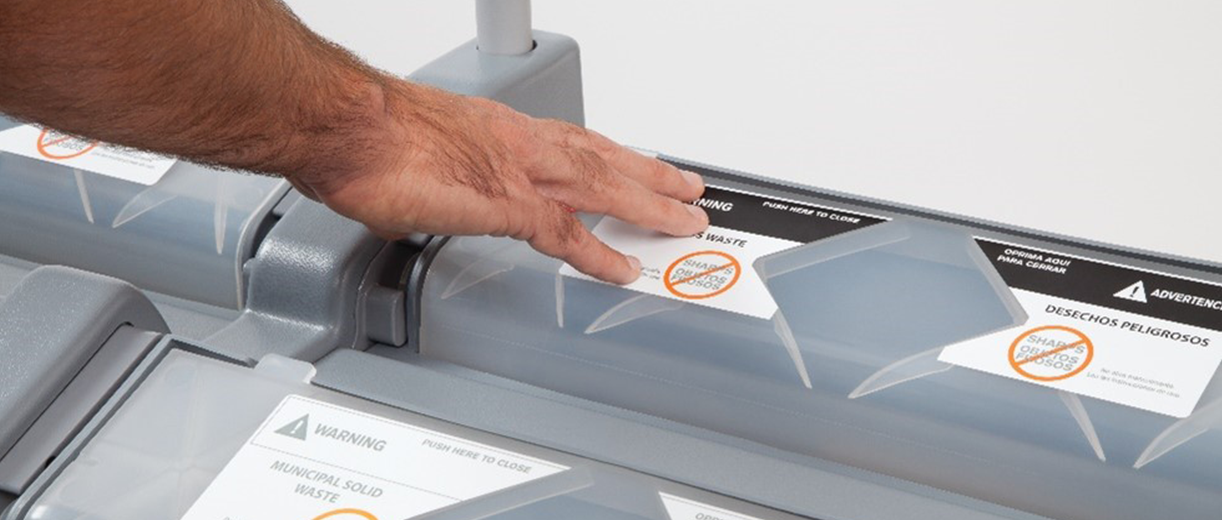The ins and outs of syringe waste disposal
Plastics are a low-cost, strong and versatile material that can easily be shaped when melted1. Single-use plastics can be replaced quickly to maintain a sterile environment2. This is one of the reasons why they are used in patient care.
Facing the challenges of syringe waste disposal
“Single-use plastics are the cleanest, most efficient way,” to promote health and hygiene in healthcare facilities according to the American Chemistry Council2.
Many industries are looking for ways to reduce and reuse plastics3. However, these approaches present challenges to healthcare facilities because single-use plastic medical devices are used to help prevent the spread of disease and infection3.
Due to the presence of sharps and patient contact, disposal options for syringes are limited because of technical and regulatory challenges4.
Reusing syringes, intravenous (IV) catheters and other single-use plastic medical devices is not recommended, as this could increase the risk of infection5,6. Patient safety is the top priority in healthcare.
More on this topic: 3 ways that BD is fighting climate change
Segregating waste for improved syringe waste disposal
“There are still certainly different types of plastics that could be recovered that aren’t being recovered today for a number of reasons,” says Kim Holmes, former vice president of sustainability at the Plastics Industry Association2.
One of the keys to improving healthcare waste management is by ensuring proper waste segregation7. By separating waste into different streams you can increase the material that gets recycled8.
“There are items used in patient care that don’t come in contact with patients so they’re not biohazards, and those could be recycled2,” specifies Kim Holmes. These components include needle shields and syringe packaging4.
It’s important to choose packaging made with mono-materials or multiple materials that are easy to separate into different recycling streams (e.g., paper and polypropylene packaging designed to be peeled apart)9.
More on this topic: BD Emerald™ Syringes: Helping patients and the planet, one injection at a time!
Non-hazardous versus hazardous waste
Out of all waste generated by healthcare, 85% is considered general, non-hazardous waste7. Non-hazardous waste doesn’t have any biological, chemical, radioactive or physical hazard6.
The remaining 15% is hazardous waste7. This includes6:
- Used or unused sharps: hypodermic, intravenous or other needles; auto-disable syringes; syringes with attached needles and infusion sets
- Infectious waste: contains pathogenic agents that could transmit diseases
- Pharmaceutical waste: contains expired or no longer used drugs or items contaminated by drugs
- Cytotoxic waste: contains substances with genotoxic properties
- Radioactive waste: contains radioactive substances
- Chemical waste: contains chemical substances
Around the world, an estimated 16 billion injections are administered each year, but not all syringes and needles are disposed of properly7.
6 best practice tips for syringe waste disposal
- Separate hazardous waste from non-hazardous waste6
- Place sharps waste (needle and syringe combination) directly into a sharps container after use6
- When possible, use smaller volume syringes as they produce less waste than larger ones
- Choose syringe manufacturers that are ISO-14001 certified
- Make sure there are an adequate number of containers for the collection of medical waste6
- Recycle all packaging that allows for material separation
For specific information on disposing pre-filled saline syringes, read the document below.
References
- Andrady AL, Neal MA. Applications and societal benefits of plastics. Philos Trans R Soc Lond B Biol Sci. 2009;364(1526):1977-1984. doi:10.1098/rstb.2008.0304
- Gibbens S. Can medical care exist without plastic? National Geographic. Published online October 7, 2019. Accessed September 26, 2022. https://www.nationalgeographic.co.uk/environment-and-conservation/2019/10/can-medical-care-exist-without-plastic
- Healthcare Plastics Recycling Council (HPRC). Barriers to Recycling Healthcare Plastics at Hospitals. Published 2022. Accessed September 22, 2022. https://www.hprc.org/barriers-to-recycling-healthcare-plastics/
- FY 2020 Sustainability Report. Becton, Dickinson and Company; 2020. Accessed September 26, 2022. https://www.bd.com/content/dam/bdcom-assets/en/en-us/documents/policies-guidelines-and-statements/reports/BD_Sustainability-report-2020_EN2.pdf
- BOSS Editorial Team. First, do no harm: How healthcare facilities balance patient and environmental safety when it comes to single-use plastics. BOSS Magazine. Published online 2022. https://thebossmagazine.com/single-use-plastics-healthcare/
- World Health Organisation (WHO). Safe management of wastes from health-care activities, 2nd ed. Published online June 12, 2014. Accessed September 26, 2022. https://www.who.int/publications/i/item/9789241548564
- World Health Organisation (WHO). Health-care waste. Published February 8, 2018. https://www.who.int/news-room/fact-sheets/detail/health-care-waste
- Okafor J. Plastic in Healthcare and Hospitals. Trvst. Published online September 10, 2021. Accessed September 22, 2022. https://trvst.world/waste-recycling/plastic-pollution/single-use-plastic-in-healthcare-and-hospitals/
- Healthcare Plastics Recycling Council (HPRC). Design Guidance. Published 2022. Accessed September 26, 2022. https://www.hprc.org/design-guidance/
This list of references to third-party peer-reviewed material and the sites they are hosted on are provided for your reference and convenience only, and do not imply any review or endorsement of the material or any association with their operators. The Third-Party References (and the Web sites to which they link) may contain information that is inaccurate, incomplete, or outdated. Your access and use of the Third Party Sites (and any Web sites to which they link) is solely at your own risk.
BD74651




